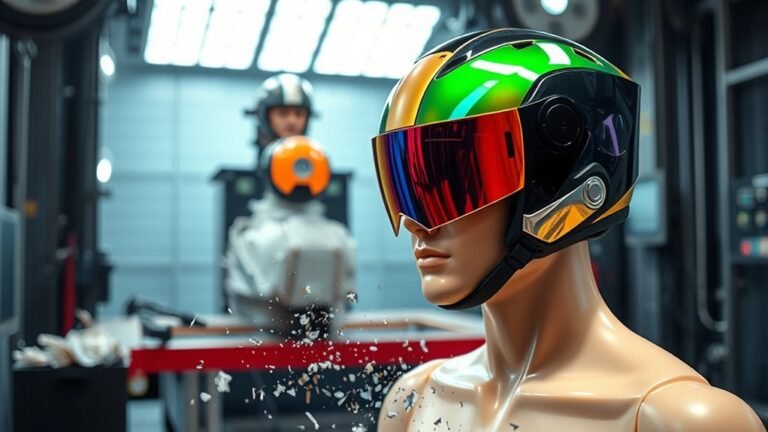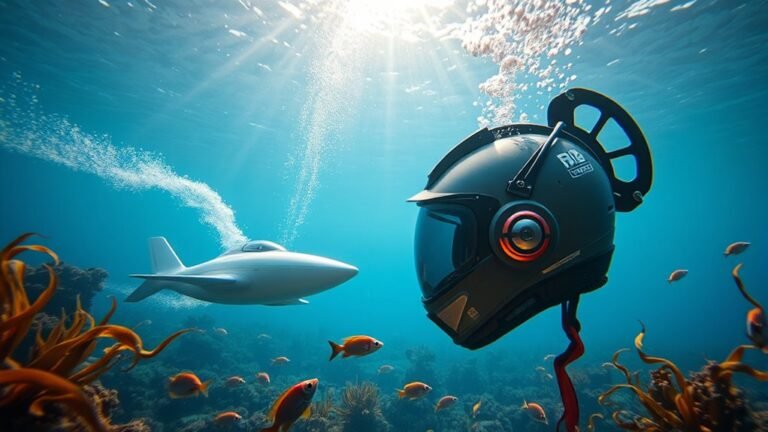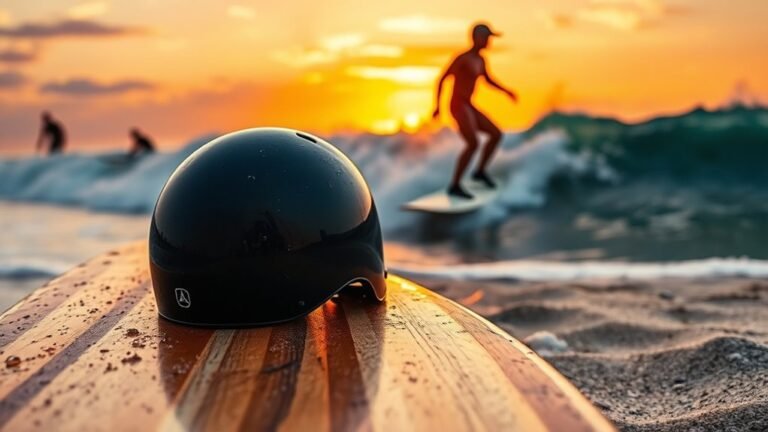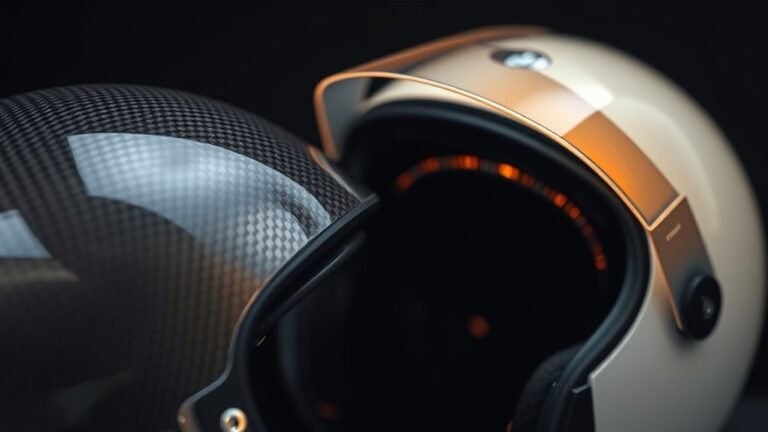Best Practices for Helmet Safety in Cosplay
For helmet safety in cosplay, always choose a properly fitted helmet that aligns with your character’s design. Make certain it’s made from durable materials like polycarbonate or fiberglass, and provides adequate ventilation and visibility. Adjust the padding for comfort and check strap security for a snug fit. Regularly maintain your helmet by cleaning and inspecting it for damage. Don’t underestimate the importance of visibility tools and communication methods. Keep exploring to uncover more tips for safe and enjoyable cosplay experiences!
Understanding the Importance of Helmet Safety
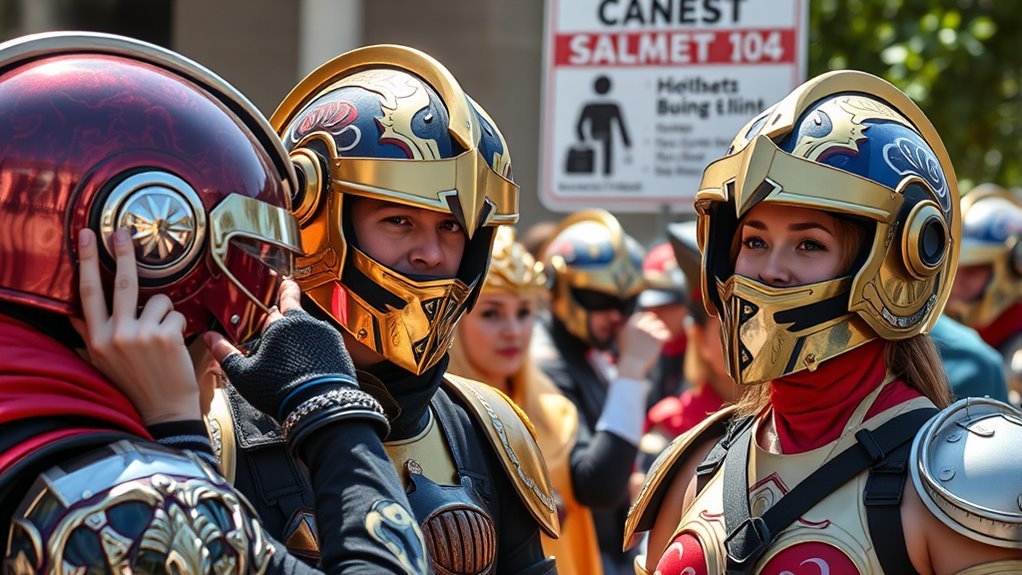
When you’re diving into the world of cosplay, it’s easy to get caught up in the excitement of creating a stunning character representation; however, understanding the importance of helmet safety can’t be overlooked. First, familiarize yourself with helmet regulations that apply in your area or at conventions, as these guidelines are designed to protect you. Properly fitted helmets can greatly reduce the risk of cosplay injuries, especially during events where crowds gather and movement is limited. Remember, a helmet isn’t just an accessory; it’s an essential piece of gear that safeguards your head. Prioritize selecting a helmet that meets safety standards while still aligning with your character. This balance empowers you to enjoy your cosplay without compromising your well-being.
Choosing the Right Helmet Type for Your Cosplay
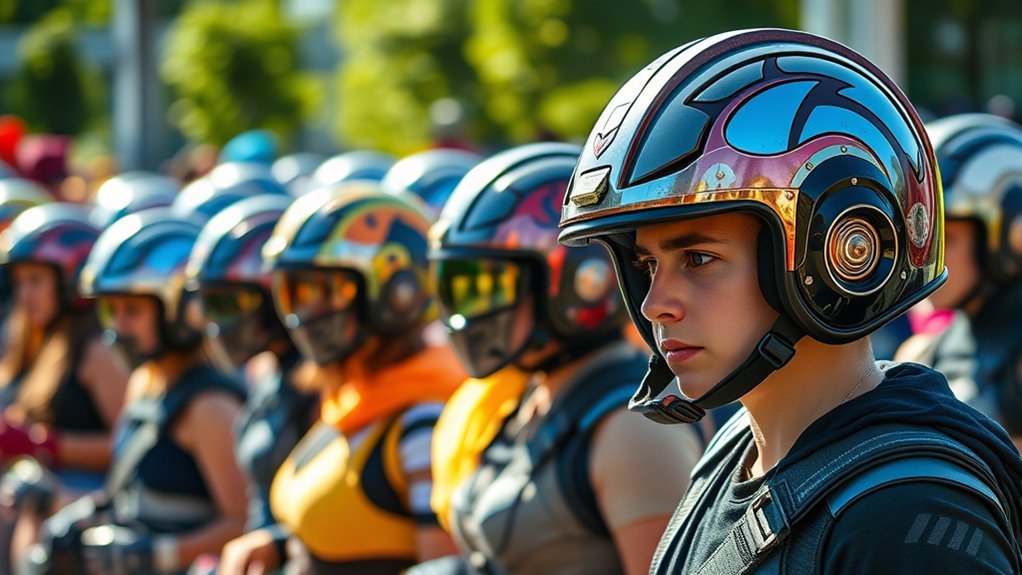
Choosing the right helmet type for your cosplay can make all the difference in both safety and authenticity. Different helmet styles cater to various needs, so it’s crucial to comprehend the features that suit your character and environment. Here are some key points to take into account:
- Material: Look for lightweight yet durable materials.
- Ventilation: Verify there’s airflow for comfort during long events.
- Visibility: Check the helmet’s visibility to avoid obstructed views.
- Padding: Adequate padding enhances comfort and safety.
- Design: Choose a design that closely resembles your character’s helmet.
Ensuring a Proper Fit for Maximum Protection
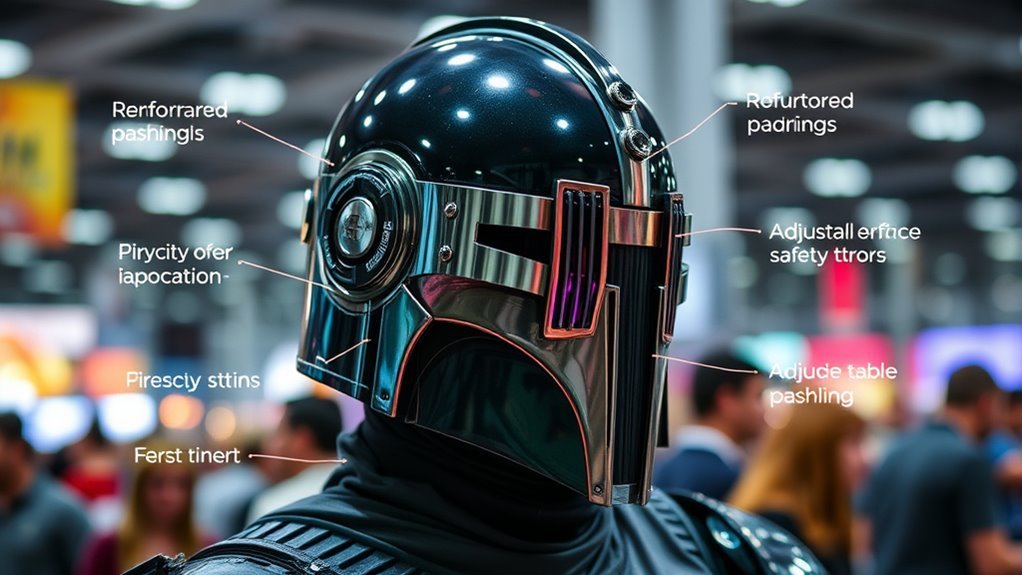
A well-fitted helmet is essential for maximizing protection during cosplay events. To guarantee your helmet fits correctly, start by consulting sizing charts specific to the brand. Measure your head circumference to find your size, and don’t rely solely on guesswork. Once you’ve got your helmet, make necessary fit adjustments. Most helmets come with padding or adjustable straps; use these features to achieve a snug yet comfortable fit. Your helmet shouldn’t wobble or slide around when you move. Remember, a properly fitted helmet not only enhances your safety but also improves your overall cosplay experience. Taking the time to guarantee the right fit can make all the difference, allowing you to enjoy your freedom while staying protected.
Materials Matter: Selecting Safe and Durable Helmets
Materials play a crucial role in helmet safety and durability, making it important to select the right type for your cosplay needs. When choosing a helmet, consider the following:
- Polycarbonate: Known for its impact resistance and lightweight properties.
- Fiberglass: Offers excellent durability and a classic, high-end look.
- EVA Foam: Lightweight and easy to mold, perfect for intricate designs.
- Acrylic: Clear options allow for visors while maintaining strength.
- Expanded Polystyrene (EPS): Commonly used for inner linings, it absorbs shock effectively.
Prioritizing material durability in your helmet construction guarantees you’ll stay safe while showcasing your creative passion. Always remember, the right materials can enhance both protection and your cosplay experience!
Ventilation: Keeping Cool While Cosplaying
When it comes to cosplaying, effective ventilation can make all the difference in your comfort and enjoyment, especially during long events. You’ll want to explore various ventilation techniques and cooling solutions to keep cool while wearing a helmet. Here’s a simple table to guide you:
| Ventilation Technique | Description |
|---|---|
| Built-in Vents | Integrated openings that allow airflow. |
| Cooling Fans | Battery-operated fans inside the helmet. |
| Moisture-wicking Liner | Fabric that absorbs sweat and promotes airflow. |
Visibility Considerations for Helmets
While staying cool is important, guaranteeing good visibility is just as essential when wearing a helmet for cosplay. You want to enjoy your time without compromising safety. Here are some visibility enhancements to evaluate:
- Use clear visors or face shields for unobstructed views.
- Incorporate reflective materials to catch light and increase your visibility, especially in low-light conditions.
- Design helmets with open sightlines, avoiding bulky features that block peripheral vision.
- Add LED lights or glow strips for extra visibility during events.
- Make sure your helmet fits securely to prevent it from shifting and obstructing your view.
Maintenance and Care for Your Cosplay Helmet
Maintaining your cosplay helmet is essential for guaranteeing both its longevity and your safety during events. Regular upkeep not only keeps your helmet looking great but also guarantees it functions properly. Use these cleaning techniques to keep your helmet fresh:
| Cleaning Technique | Frequency | Repair Tips |
|---|---|---|
| Wipe with a damp cloth | After each use | Check for cracks |
| Use mild soap | Weekly | Reinforce seams |
| Disinfect interior | Monthly | Replace padding if worn |
Always inspect your helmet for damage. If you notice any issues, don’t hesitate to apply these repair tips. A proactive approach helps you enjoy your cosplay experience without worrying about safety or appearance!
Testing Your Helmet for Safety and Comfort
Before you step into the spotlight at your next event, it’s essential to test your helmet for safety and comfort. A proper fit and reliable protection can make or break your cosplay experience. Here’s how to guarantee your helmet is ready:
- Impact Testing: Drop your helmet from a height to check for cracks or damages.
- Comfort Assessment: Wear the helmet for an extended period to gauge comfort levels.
- Strap Security: Confirm all straps are secure and adjustable.
- Weight Distribution: Check if the helmet feels balanced on your head.
- Ventilation: Verify there are adequate airflow vents to avoid overheating.
Testing your helmet thoroughly can help you avoid discomfort and guarantee your safety while showcasing your impressive cosplay.
Additional Safety Gear: Enhancing Your Cosplay Experience
When you’re gearing up for cosplay, don’t overlook the importance of additional safety gear. Essential protective accessories, visibility and communication tools, and comfort enhancements can greatly improve your experience. By integrating these elements, you’ll not only enhance your safety but also enjoy greater mobility and connection with fellow cosplayers.
Essential Protective Accessories
While you might be focused on perfecting your costume, incorporating essential protective accessories can greatly enhance your cosplay experience. Besides helmet safety, accessory integration is key to ensuring your overall well-being while maintaining those stunning visual enhancements. Here are some must-have accessories to take into account:
- Padding: Cushioned inserts for comfort and impact protection.
- Gloves: Protect your hands and improve grip, especially with props.
- Knee and Elbow Pads: Shield your joints during active movements.
- Shoes with Grip: Prevent slips and falls, especially on various surfaces.
- Face Shield or Goggles: Protect your eyes without sacrificing style.
Visibility and Communication Tools
To fully enjoy your cosplay experience, it’s crucial to contemplate visibility and communication tools that enhance both safety and interaction. Consider adding reflective materials or LED lights to your helmet for effective visibility enhancements. These not only help you stand out but also guarantee others can see you clearly, especially in crowded events.
For communication signals, think about integrating a simple gesture system or light indicators. For instance, using colored lights to signal your intent can improve interactions with fellow cosplayers and attendees. You might also want to use a voice amplifier if your helmet muffles sound, allowing you to communicate seamlessly. By prioritizing these visibility and communication tools, you can navigate events safely while enjoying the freedom of expression that cosplay offers.
Comfort and Mobility Enhancements
Though comfort may not be the first thing that comes to mind when assembling your cosplay, it plays a vital role in guaranteeing an enjoyable experience. Enhancing your helmet’s comfort and mobility can make a big difference throughout your event. Here are some tips to take into account:
- Padding adjustments: Use high-quality foam to fit snugly without pinching.
- Strap systems: Opt for adjustable straps that distribute weight evenly.
- Ventilation: Incorporate small vents to allow airflow and reduce heat buildup.
- Weight distribution: Balance your helmet’s design to feel lighter on your head.
- Breakaway features: Confirm your helmet can detach quickly in case of emergencies.
Implementing these enhancements allows you to enjoy your cosplay without compromising safety or comfort.
Frequently Asked Questions
Can I Customize My Helmet Without Compromising Safety?
Yes, you can customize your helmet without compromising safety. Start by using safety materials like impact-resistant plastics or foam for any modifications. Incorporate customization techniques such as painting or adding accessories, but make certain they don’t obstruct visibility or ventilation. Always check that your alterations maintain the helmet’s structural integrity. If you’re unsure, consult with experts or reference guidelines to keep your creative expression aligned with safety standards. Enjoy your cosplay journey!
How Do I Clean My Helmet Effectively?
To clean your helmet effectively, focus on the materials and cleaning solutions. First, remove any padding or liners, if possible. Then, gently wipe the exterior with a microfiber cloth and a mild soap solution, avoiding harsh chemicals. Rinse thoroughly and dry. For visors, use a dedicated cleaner to prevent scratches. Remember, maintaining your helmet’s integrity is essential. By keeping it clean, you’re ensuring safety and comfort during your cosplay adventures.
Are There Specific Regulations for Cosplay Helmet Safety?
Yes, there are specific cosplay regulations regarding helmet safety. You should always check local laws and event guidelines, as they may require adherence to certain helmet standards. For instance, some conventions might mandate that helmets meet specific impact resistance criteria. Confirm your helmet fits properly, is secured correctly, and doesn’t obstruct your vision. By following these regulations, you can enjoy your cosplay experience while staying safe and compliant with event policies.
Can I Wear Glasses Under My Helmet?
Yes, you can wear glasses under your helmet, but you’ll need to take into account glasses compatibility and comfort. Make certain your helmet’s interior allows enough space for your frames without pushing them against your face. If your helmet fits snugly, you might need to make vision adjustments, like using contact lenses instead. Always test it before heading out to verify your vision’s clear and you’re comfortable in your cosplay. Safety and style can go hand in hand!
How Do I Transport My Helmet Without Damage?
To transport your helmet safely, consider clever carrying methods. First, use a padded pouch for secure storage, preventing scratches and scuffs. If you’re driving, place it on a soft surface, like blankets, to cushion against bumps. When flying, tuck it in your carry-on, ensuring it stays snug. Avoid stacking heavy items on top; you want your helmet to travel undamaged and ready for action. Remember, careful transport keeps your helmet in top shape!

